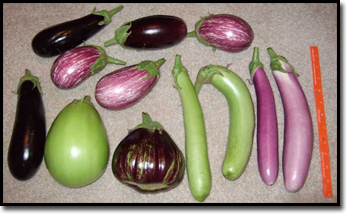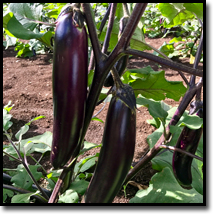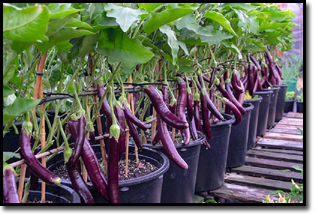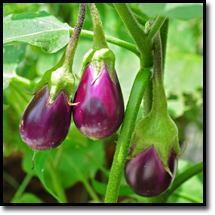
Growing Eggplant
Introduction
| Eggplant (Solanum melongena) is part of the Solanaceae family. This botanical family, commonly known as the nightshades, includes other species like peppers, potatoes, tomato and tobacco. |  |
The species also goes by the common names "aubergine" (UK & Ireland) and "brinjal" (Indian subcontinent, Singapore, Malaysia, South Africa).
Bitter Apple
It was originally domesticated from the wild nightshade species thorn or bitter apple (S. incanum), seemingly with two separate domestications originating in South Asia and another in East Asia. In 2018, China and India combined accounted for 87% of the world production of eggplants.
Types
There are many varieties of eggplant that grow well here in Hawaii.
A few popular local varieties are the Waimanalo Long (B-1), UH Long Green, New Poamoho Dark Long and the Nitta Waimanalo (Hybrid).
Waimanalo Long (B-1) - Waimanalo long is a long slender high quality eggplant around 8-12 inches in length, with a rich purple color. Matures in about 3-4 months.
Waimanalo Long
UH Long Green
UH Long Green - Long oriental type eggplant but in a nice light green color. Very tender and excellent for cooking. Fruits are 8-12 inches in length. Matures in 4 months. Excellent producer for backyard gardens.
Poamoho Dark Long
New Poamoho Dark Long - Is a "New" long oriental type eggplant that was developed for wilt resistance. This new release was from former Vegetable Specialist, Dr K. Takeda's collection. Fruits are 10-12 inches in length. Very nice dark glossy purple color. Matures in about 3-4 months.
Nitta Waimanalo (Hybrid) - Is a hybrid eggplant with a rich purple color that is slightly larger than the Waimanalo Long eggplant. Fruits are range about 8-12 inches in length but slightly larger in diameter.
Nitta Waimanalo (Hybrid) Eggplant
Germination & Propagation
Plant one or two seeds per starter pot in a quarter inch hole and cover lightly with soil. Keep watered and moist until the seeds form seedlings. If more than one seed sprouts, cut the extraneous seedlings at the base with a pair of scissors so that there is only one plant per pot.
Eggplant seeds germinate in 7 to 14 days, depending on the heat, moisture provided, and moisture content and age of the seed. Seedlings with two sets of leaves can be transplanted into 4-inch or 2-by-2-by-6-inch pots two to three weeks after germination.
Seeds are best stored in the refrigerator and can be purchased directly from us via our Seed Store. We get our seed stock directly from the College of Tropical Agriculture and Human Resources (C/T/A/H/R), University of Hawaii at Mānoa.
To grow eggplants from cuttings, first take your cuttings from existing plants at the end of the growing season and start them indoors. Wait a couple of weeks after the last frost to ensure that warm weather is on its way before moving them into the garden as eggplants need warm soil in order to grow.
Planting
Eggplant can be grown in the ground or a container. They can also be grown on a lanai using a supporting trellis or similar structure to help keep the plants upright. Keeping the plants upright help to prevent insects away and makes it easier to prune and harvest.
To transplant, carefully remove the starter tomato plant from the original container and place it into the hole in the new, larger container.
It is best to use a trellis or cage (typically used for tomato plants) so the eggplant will be supported as their stems grow. Make sure the trellis or cage is placed at the base of the plant.
Use cages to prevent the plants from toppling over
If you are using a container to grow eggplant, it should be large enough to allow the vegetables to grow properly. I would suggest 5 gallon containers with plenty of drainage.
Eggplant Growing in Containers
Use the Best Hawaiian Soil Mix once seedlings have established themselves.
Prune the lower shoots to allow for the fruit to form fairly high above the ground. This helps control the bug count. Adding organic mulch five weeks after transplanting starters will help to control weeds and retain moisture in the soil.
Prune the lower shoot while the plant is still young
Sun and Water
Eggplant requires a lot of sun so where one chooses to grow them will influence the eventual yield.
Full sun is preferable, with a minimum of six hours of direct sun per day needed to maintain healthy growth.
Eggplant enjoy access to a lot of water. It is best to keep the soil moist and watering in the morning is best. During the rainy season, it is fine to keep watering at a minimum but during the hot summer months, it is best to water consistently especially if you are using containers.
Fertilizing
Eggplant is a heavy feeder and requires copious amounts of plant food. It is best to start off with balanced fertilizers and transition to phorophorus dominant plant food to boost fruit production. Top feedings with guano and liquid fertilizer solutions, like an organic tea, is suggested.
Pollination
While wind, the birds and insects (like bees) will pollinate your plants doing it manually will ensure eggplant production. This can be done by vibrating (use an electric toothbrush) the stems to simulate the wind or birds.
Both male and female plants produce eggplant. Males tend to have fewer seeds, and are therefore less bitter than female eggplants. To sex an eggplant, look at the indentation at bottom. If it's deep and shaped like a dash, it's a female. If it's shallow and round, it's a male.
Male Eggplant on the Left and Female on the Right
Harvesting
Harvesting eggplants should occur when the inner flesh is cream colored, fruits are firm and before seeds are visible. Learning when to harvest eggplants may require cutting into the fruit to check the color of the flesh and the size of the seeds.
Eggplants do not ripen off the vine and deteriorate rapidly, becoming spongy. Eat the eggplant as soon as possible after picking it. You can store it overnight at room temperature.




















